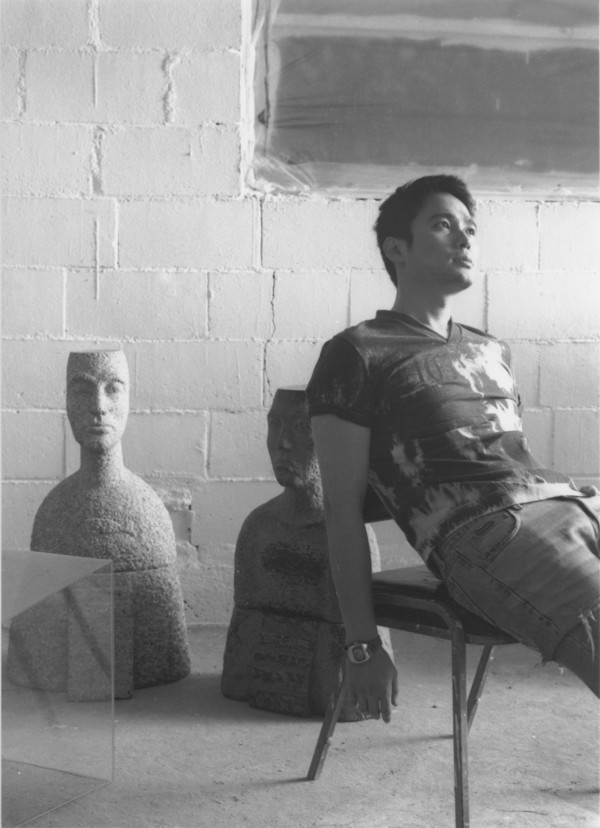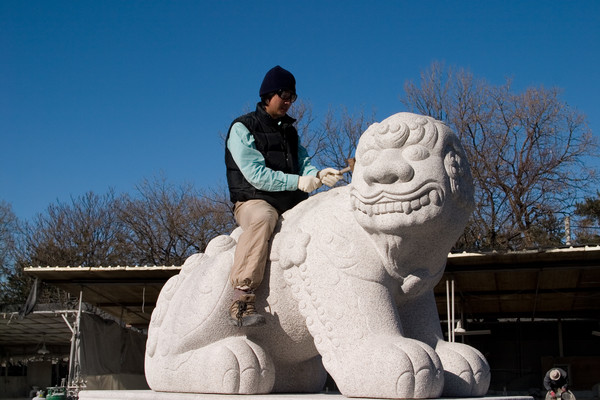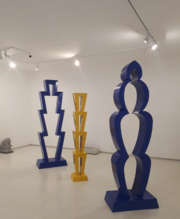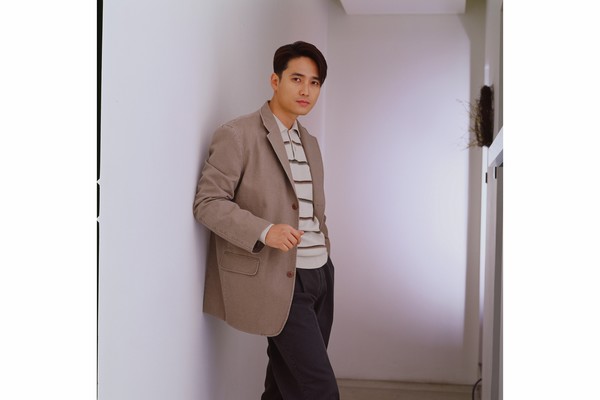
Choi Jin-ho is a sculptor who carves culture with hands and heart. He made a delicate scent of culture with his sculptures. Choi Jin-ho creates diverse sculptural culture by using various materials and making large sculptures, some over 20 meters high, to small hand-sized works. Choi Jin-ho is also a remarkable Haechi sculptor in Korea, and he represents Haechi worldwide. He made Haechi sculptures for the International Court of Justice (ICJ), the Philadelphia City Hall, and the Australian National University (ANU). Choi Jin-ho was a model for diverse companies such as Samsung Publishing Company and Hyundai Motor Company. He also gave lectures related to art at Chung-Ang University, Gangneung National University, and Daegu Kyungil University, and modeling lectures at Dongduk Women’s University and Seokyeong University. Choi Jin-ho has unlimited potential, and he continues to improve. Let’s listen to the story about Choi Jin-ho with CAH.
Q1. Can you introduce yourself to CAU students and people reading this article?
Nice to meet you. I am Choi Jin-ho. I majored in Sculpture at Chung-Ang University in 1987. I am glad to include my story in the Chung-Ang Herald that I saw when I was in university. I am a sculptor. Until now, I have held 12 solo exhibitions, and the representative work is the Haechi sculpture, the symbol of Seoul. At the Seoul City Hall, there is the Flowering Haechi. I have created various sculptures, too. I also worked as a model for many advertisements in 1988 when I was a second-year student at Chung-Ang University. Currently, I am an ambassador for the National Trust for Cultural Heritage, and I work in Australia and Korea.
Q2. How did you first encounter sculpture? When did you start to feel interested in sculpture?
I went to an art academy when I was in high school. At that time, my teacher had majored in Sculpture while in university. While learning pencil sketch, I heard about the charm of sculpture touching the soil and the process of making his own art as a sculptor. I experienced sculpture by hearing the story, and coming across some sculptures, which led to my interest in it.
Q3. You are a unique Korean sculptor specializing in Haechi sculptures. What is "Haechi" and what does it mean?
Haechi is an imaginary animal that discerns right and wrong and keeps justice, also called "Haetae." Haechi is an animal of justice and integrity. It is also a symbol of the royalty of the Joseon Dynasty and Saheonbu (Office of Inspector General in Joseon Dynasty). Therefore, government officials of Saheonbu wore hats with Haechi drawn on them. Government officials also touched Haechi's tail to restore the mind of integrity. Besides, Haechi is installed at the entrance of the palace, such as Gwanghwamun Gate. That is because the people of Joseon thought that Haechi is a guardian against fire or disaster. Currently, Haechi is also a symbol of Seoul.

Q4. It would have been hard to modernize the traditional Haechi sculpture in Korea. What did you consider while making it a modern work?
The Haechi sculpture in front of Gwanghwamun Gate was made by a mason named Lee Se-wook in the Joseon Dynasty. I think this sculpture is very well-made. During the Joseon Dynasty, tigers were frequently seen. Haechi is an imaginary animal, but there are parts similar to the forefoot and body parts of the tiger. Thus, I think that it might have been made by looking at actual animals. The traditional Haechi we known was threatening because of its fierce expressions that emphasized a corrugator. For the modernization of the Haechi sculpture, I researched traditional Haechi sculptures such as the Haechi of Suwon Hwaseong Fortress. Also, I received professional advice from Professor Kim Eon-jong (Department of Classical Chinese at the Korea University), Professor Choi Chong-ko (School of Law at the Seoul National University), and other experienced sculptors. To change its body shape, I tried to express an aesthetic quality of leanness by extending legs and body of Haechi. I made the new Haechi sculpture with a smiling face, making it different from the existing Haechi sculptures. Also, I tried to produce a flowering hatch that contains the meaning of a delicate scent of culture.
Q5. You're not only creating Haechi, but also various sculptures. The 2011 Korean Popular Culture and Arts Awards trophy was also very impressive. What did you focus on while making this trophy?

The Korean Popular Culture and Arts Awards is a national medal given to pop culture artists by the Korea Creative Content Agency, a Ministry of Culture, Sports, and Tourism-affiliated organization. I thought this award recognized the contribution to those who have been passionate about one thing throughout their lives. One day, I saw the Korean Popular Culture and Arts Awards trophy in a charnel house, and I thought it was a meaningful award that gave honor to the winner's life. Therefore, I thought about the design of the trophy a lot. First of all, the grip feeling when holding the trophy with one hand is important, so I designed the bottom part to be thin. I drew with a brush and decided to show a dynamic motion for the top part. I chose the sketches that go well with the Korean Popular Culture and Arts Awards and shaped the image.
Q6. What is your sculptural philosophy?
I think it is significant to create works that give visual beauty and stereoscopic effect. But also, it is important to make the invisible meaning touch the viewer’s heart serenely. Thus, I am trying to focus on meditating on the significance of the work. I also try to do a lot of research. When I was working on the poem stone of the poet Cheon Sang-byeong, I did a lot of research on Cheon Sang-byeong's life. Therefore, I often went to a cafe named "Gwicheon" in Insa-dong and met with Mook Soon-ok, Cheon Sang-byeong's wife. I heard about how he lived. When making a sculpture about his poem "bird," I considered historical research such as what was on Cheon Sang-byeong's desk, like the makgeolli bottle at that time. I installed the Haechi sculpture at the International Court of Justice (ICJ) and Seoul City Hall through the contest. I tried to research and study about Haechi more and produced work.
Q7. You are trying to create works with various materials such as stainless steel. Is there any material that you are interested in recently?
I primarily use materials such as granite and bronze. When I work with granite, I use hammering and minimize the use of machines to more carefully control the craft. In the case of steel, I try to use urethane painting or make the impression of a color. Following scientific advances, I use building materials such as duralumin, which can withstand the elements well. In the future, I want to create outdoor sculptures using LED lights for night viewing. I also want to utilize new building materials and make sculptures in public space.
Q8. We think it is sometimes hard to create new things continuously. Is there anything that you consider to continue creating various works?
The main thing is imagining, sketching, and continuously experiencing things. I have indirectly experienced through reading and got new energy for creating. Actually, I had sketched while reading the travel essay "Longue Marche" by Bernard Ollivier. After that, I won a prize with a piece based on that sketch and I could install my works in Cheonan-Asan. I also gain lots of energy through traveling. While traveling, I sketch new thoughts and feelings.
Q9. In 2019, you held the 12th solo exhibition at the Kwanhoon Gallery, showing sculptures that conveyed the meaning of emptiness and filling. What are the criteria for selecting a theme for a solo exhibition?

People experience different things at different times. My mother passed away around the time when I held my 12th solo exhibition. I felt so empty but I felt that I was filling up when looking at my youngest daughter, so I made that thought into a formative style. I expressed it sculpturally. My 12th solo exhibition was held under the theme for ‘Empty and Fill.’ It refers to the sadness felt in the process of going through a life-and-death break up with one’s mother, along with the beginning of the next generation which gives the new power of filling.
Q10. Let’s move on to your college days! Is there any school activity that helped you as a sculptor?
I went on a school trip when I was in my 3rd year. I was a departmental student representative at that time. All of my classmates talked about going to Jeju Island, so I told Park Suk-won, the professor in charge, about it. He was a professor at Jeonbuk National University before coming to Chung-Ang University. He said that there are good statues of Buddha and mountains in Jeolla-do, so it is better to go to a place like this to study Sculpture. He planned an itinerary including Hwasun Unjusa Temple, Jinan Maisan, Hong Island, and Heuksan Island. I loved those experiences. I was able to open my eyes to walk the path of a sculptor by going through a precious experience that I could not learn from the university. It might sound silly but there are so many things to learn away from school, not only in classes. I think that students can learn a lot of bigger things when they are outside of school. There will be more diverse paths of learning if they do things like going to various places in Korea.
Q11. What do you remember the most during college life?
I was shocked and in sorrow when Patriotic Martyr Lee Nae-chang, president of the student body and class of 1990 in the Department of Sculpture, suddenly died a mysterious death. This still remains a mystery and I hope something will be found out about this someday. Also, I backpacked through Europe for the first time during the summer vacation in 1989. I went to France, Spain, Belgium, Italy, and the United Kingdom. The shock of novelty I got from the trip made me think that traveling to Europe was more valuable than a year of school.
Q12. Your experience as a model in college also seems to be receiving a lot of attention along with your works. You have debuted as a model in 1988. What made you decide to go for it?

Back in 1987, there was no practical building for the Department of Sculpture. There were small practical rooms for that department on the 1st floor of the Department of Painting building. Because of that, there were too many demonstrations to get a practical building for the Department of Sculpture, so my school life was boring. That is why I applied for the 16th Modelline recruitment when I heard about it through a radio commercial during the winter vacation. In March 1988, I got selected. I worked as a model while attending university and graduate school. I worked hard in school while working in advertising and fashion. Fortunately, there was no problem with school life because I did a lot of modeling during the vacations. I think meeting more people, doing various work, and having diverse experiences were helpful for me.

Q13. You said that the pursuit of visual beauty is in common with model and sculpture. How did your experience as a model help you work as a sculptor?
The good thing about being a model was good location places. I went to Australia or New Zealand a lot. Also, I went to Canada, Singapore, and other beautiful places for photo shoots. These journeys helped me to devise sculptures. Moreover, I used a lot of materials that I wanted with money I earned. There is something in common in showing the value of beauty of sculpture and a model pose. I think there is something in common with aesthetic expressions. Along with the golden ratio, the value of beauty according to the trend of the times is to express one’s own value by creating images of visible and invisible parts. I tried to emphasize and teach those to students when I worked as a lecturer.
Q14-1. In an interview with Munhwa Ilbo, you said that the field trip to Unjusa Temple that you went on in college had a lot of influence on making your works.
Actually, I am Christian, but I wondered where I could find Korean traditional beauty and where that beauty is left in Korea. The beauty can be found especially in temples, regardless of one’s religion. In particular, the natural distribution of the Cheonbul Cheontap of Hwasun Unjusa Temple touched my heart and made me think that I should make stone sculptures. I also liked the natural sculptures that seemed as if ordinary people made those, not being well-cut. Furthermore, I visited Angkor Wat in Cambodia and Easter Island for sculptural experience and expanded my perspective on sculptural research.
Q14-2. What was the difference that you felt from the statues of Buddha in Unjusa Temple at that time?
Those were not made by one person, but by various masons, so their forms were diverse rather than being all similar. A new technique of stone sculpture could be seen, not like formalized Buddha statues. I could also find the faces of our ancestors from the pure faces of Buddha statues with common-law figures. Moreover, the natural beauty of the statues was different from ordinary Buddha statues. I thought that I should also make sculptures capturing the trend of the times and thought a lot about it.
Q15. Do you have any goals you want to achieve in the future?
I once worked as the artist-in-residence at Australian National University for about a year. It was a time that worth more than money. I donated a sculpture named Korean Space to the university. It is still a sculpture that promotes Korea on the school’s campus. Like this experience, I want to promote Korea in Australia and promote the culture of Australia in Korea. A long time ago, I held a group exhibition named Kimchi Meets Vegemite several times with Robert Liddicoat who is my Australian father-in-law. I continuously want to participate in this kind of cultural exchange exhibition actively. Moreover, I love our Korean cultural heritage a lot, so I want to be more active in protecting and promoting it.

Q16. Lastly, if you have anything you want to tell the students at Chung-Ang University, please feel free to tell them.
The meaning of a ship’s existence is not that it is safely tied to a harbor. A ship’s existence has meaning when even though a storm blows over a vast ocean, it has courage to go forward, overcome, and challenge it. Rather than being in a safe place, I had a lot of experiences of knocking on doors myself, not thinking about whether it will work or not. At those times, some doors were open, so I know the sense of accomplishment. That is why I want to say this to the students. Don’t be afraid of failure, but try knocking on doors in wider areas. Give it a try.
With the interview with Choi Jin-ho, we could get a glimpse of his passion for sculpture. Moreover, the more we talked with him, the more we could know how much he had thought and studied. He didn’t keep what he learned from his experiences to himself. Through activities such as university lectures, he shared them with many students. Above all, he emphasized experience outside of school. It contains his deep meaning to build various new experiences and learn more. Also, as he said at the end, let’s face life with courage. CAH looks forward to and supports the future goals of Choi Jin-ho, the sculptor who creates great works.

